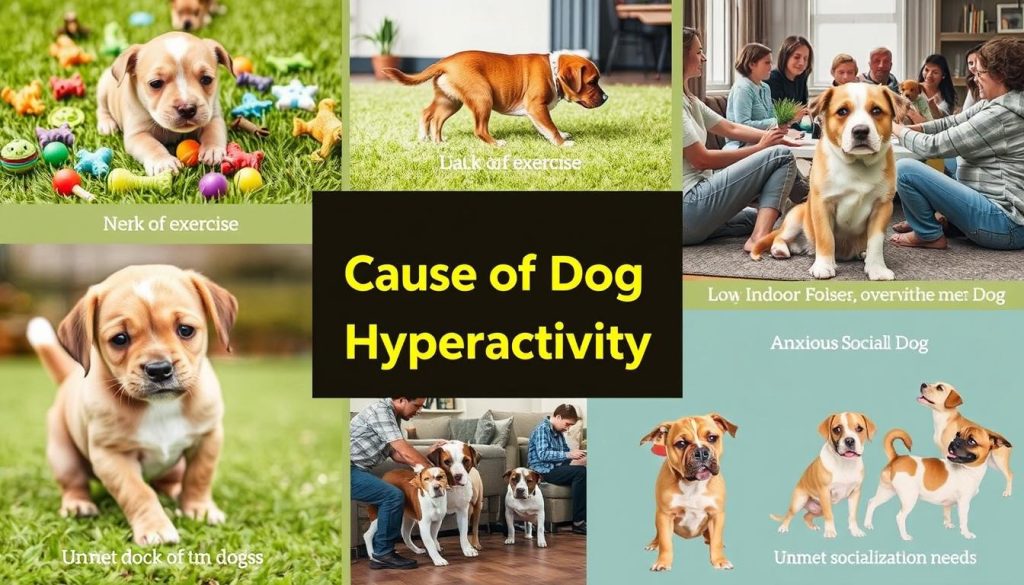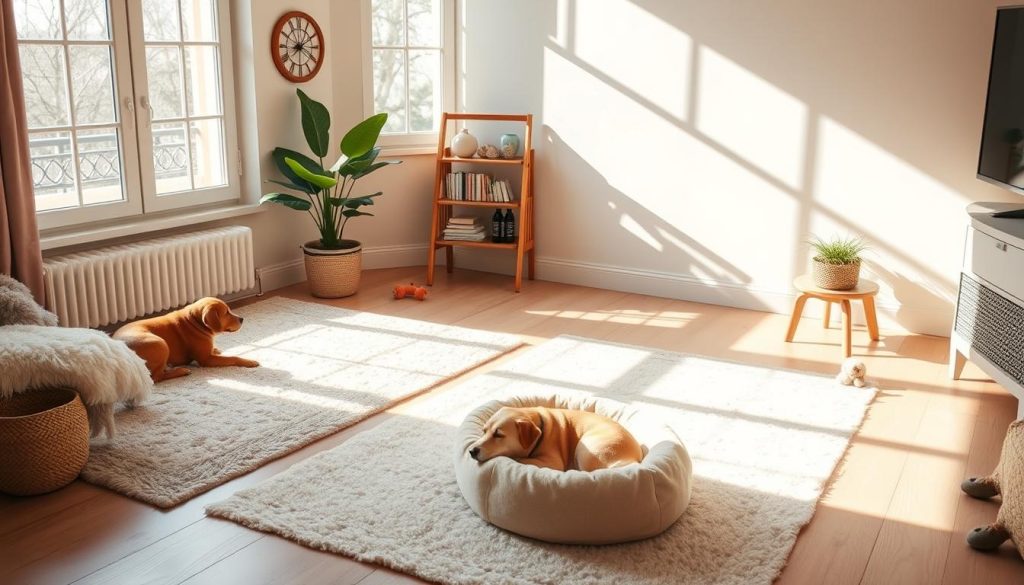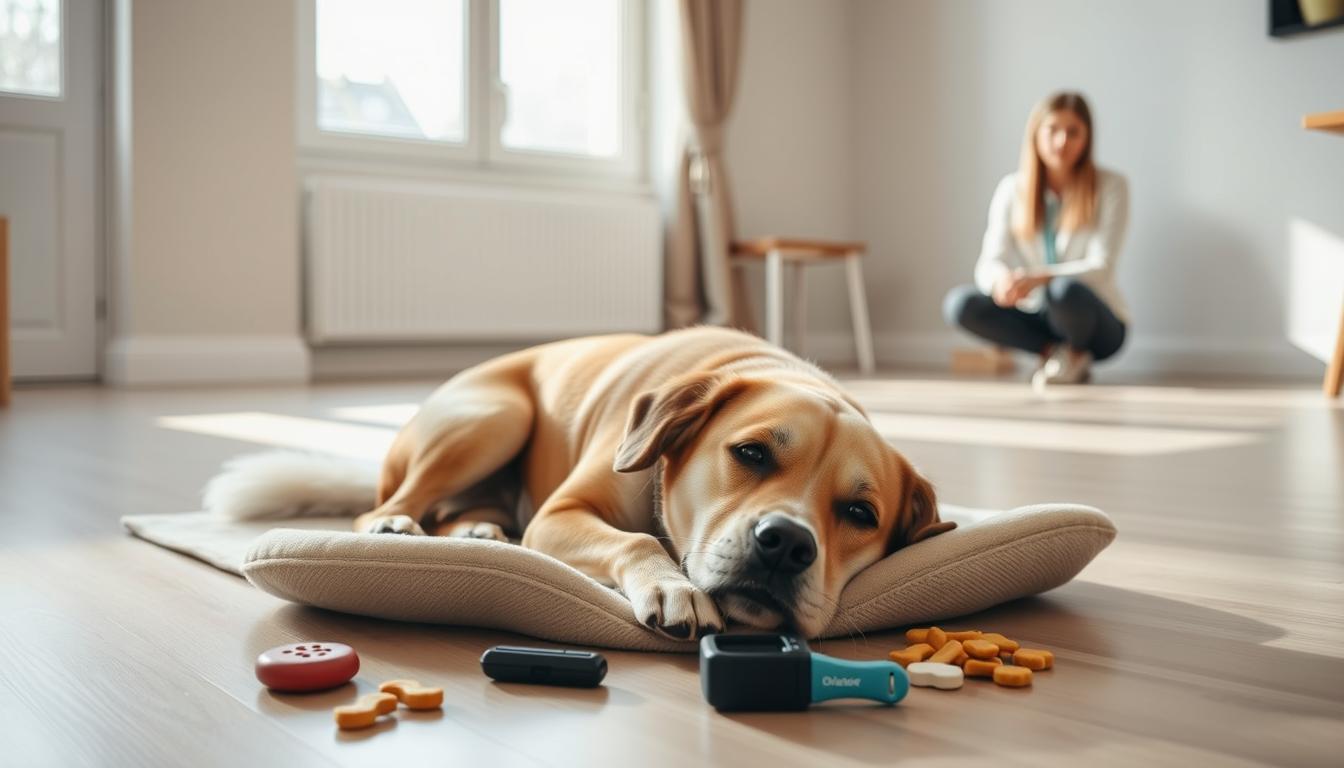Ever wished your dog could relax and enjoy quiet moments with you? Teaching your dog to be quiet can really help with their hyperactive behavior. We’ll show you how to make your dog calmer and happier.
We’ll look at why dogs get hyperactive and how to make your home peaceful again. You’ll learn important commands and how to keep your dog active. This will help turn your energetic dog into a calm friend.
Understanding Why Dogs Develop Hyperactive Behavior
Figuring out why dogs get hyperactive is the first step to solving this problem. There are many reasons, like breed-specific energy and environmental factors. Knowing these reasons helps manage your dog’s energy and make your home calmer.
Some dog breeds, like herding and sporting groups, are naturally more energetic. They were bred to be active and alert. Without enough exercise and training, their energy can turn into hyperactivity.
Environmental stressors, like changes in routine or new places, can also make dogs hyperactive. Knowing what triggers your dog’s hyperactivity helps manage these situations. Sometimes, health issues like thyroid problems or neurological conditions can also cause hyperactivity.

Quick Recommendation : Our blog is filled with tips , tricks, and methods for training your dog. If you would like to attend a Free Dog Training Workshop, we recommend the K9 Training Institute.
Understanding why dogs get hyperactive helps you find solutions. It’s important to know the signs of hyperactivity and the difference between it and playful behavior. This way, you can support your dog in a way that helps them thrive.
Creating a Calm Environment for Your Dog
Making your home dog-friendly is key to reducing stress and creating a peaceful space for your pet. By designing your living area thoughtfully, you can make a calming atmosphere. This helps to reduce your dog’s hyperactive behavior.
Begin by thinking about your home’s lighting. Soft, natural light can calm dogs. Use dimmers or lamps with warm, low-intensity bulbs. Avoid harsh overhead lights, as they can stress your dog out.

Quick Recommendation : Our blog is filled with tips , tricks, and methods for training your dog. If you would like to attend a Free Dog Training Workshop, we recommend the K9 Training Institute.
Reducing noise is also vital for a calm home. Loud sounds, like blaring TVs or music, can make dogs anxious. Add sound-absorbing materials, like carpets or rugs, to make it quieter. Also, give your dog a quiet spot to take a break from daily noise.
Organizing your home can also help reduce stress for dogs. Keep clutter low and make sure your dog’s things are easy to find but not in busy areas. This makes your dog feel safe and less stressed in their environment.
Essential Commands for Managing Excited Behavior
Learning basic dog obedience commands is key to handling your dog’s excited behavior. Teaching them “sit,” “stay,” “leave it,” and “settle” helps with impulse control. These commands are vital for setting boundaries and focusing your pet when they get too excited.
Start with the “sit” command. It teaches your dog to pause and listen to you, not get too hyper. The “stay” command helps them stay calm, even when there’s a distraction. The “leave it” command is great for keeping them away from things that might make them too excited.
The “settle” command is a big help in managing excitement. It teaches your dog to relax and calm down. With regular practice and positive feedback, your dog will learn these commands. This will help you manage their excitement and create a more peaceful home.
Training Your Dog for Quiet Time: How to Reduce Hyper Behaviour
Teaching your dog to relax can change their hyperactive ways. By using dog relaxation techniques and calming exercises for dogs, you can help them behave better. This makes your dog a more peaceful and well-behaved friend.
Start by teaching your dog to be quiet in certain spots at home. Use treats or praise to reward them when they calm down. As they get better, make these quiet times longer. This helps your dog learn to relax on their own.
Try calming exercises like gentle massage to help your dog relax. Make sure they enjoy these activities. Being consistent is important, so do these exercises every day.
Every dog is different, so be patient and find what works best for your dog. With effort, you can teach your dog to be quieter. This will make your relationship with them more peaceful and enjoyable.
Establishing a Regular Exercise Routine
Keeping your dog active is key to managing their hyperactive behavior. The right amount and type of exercise depends on their breed, age, and energy level. It’s important to mix physical activity with mental stimulation to keep them happy and healthy.
High-energy breeds like herding or sporting dogs need daily vigorous exercise. This could be brisk walks, jogging, swimming, or playing fetch. Lower-energy breeds might enjoy shorter walks and interactive play or puzzle toys.
Every dog needs at least 30-60 minutes of exercise daily. This can be split into several sessions. Make sure to adjust the routine as your dog ages or their energy levels change.
Creating a regular exercise routine helps reduce hyperactive behavior. It makes your dog calmer and more relaxed. Being consistent is crucial to give them the structure and stimulation they need.
Quick Recommendation : Our blog is filled with tips , tricks, and methods for training your dog. If you would like to attend a Free Dog Training Workshop, we recommend the K9 Training Institute.
Using Positive Reinforcement for Calm Behavior
Learning how to use reward-based training is a big step towards helping your dog feel calm. By giving treats or praise for good behavior, you teach your dog what’s expected. This helps them act more relaxed.
Clicker training is a great way to use positive reinforcement. The click sound tells your dog they did something right. This makes them connect calm actions with rewards. Soon, they’ll look forward to doing these actions.
Consistency is key in positive reinforcement. When your dog acts calm, give them a treat or praise right away. This consistent feedback will make them more relaxed and well-behaved over time.
Setting Up a Designated Quiet Space
Creating a quiet space for your dog is key to reducing hyperactive behavior. It’s a safe place for them to relax and recharge. Make it cozy and free from distractions.
Dog crate training is a great start. Pick a crate that lets your dog move around comfortably. Place it in a quiet spot and use treats to make it welcoming.
Next, choose a room or corner as a safe space for dogs. It should be quiet with soft music and calming scents like lavender. This will make it a canine retreat area your dog will love.
Teach your dog to enjoy this space by giving them treats and praise. Soon, they’ll see it as a place of safety and calm. This helps manage their hyperactive behavior.
Managing Triggers and Preventing Overstimulation
As a dog owner, knowing what makes your dog stressed is key. Things like loud noises, new places, or certain people can upset them. By figuring out these triggers and acting early, you can stop your dog from getting too excited.
Managing your dog’s environment is important. Look at where your dog lives and make changes to avoid stressors. For example, if loud appliances scare your dog, move them to a quieter room. Or, if sudden sounds bother them, use white noise machines or keep windows closed.
It’s also vital to manage your dog’s stress. A regular exercise routine helps them release energy in a good way. Also, give them calm activities like puzzle toys to keep them focused and calm.
Understanding your dog’s stress points and managing their space and stress can keep them calm. Remember, every dog is different. It might take some trial and error to find what works best for your pet.
Incorporating Calming Tools and Techniques
Managing hyperactive behavior in dogs can be done with calming tools and techniques. There are many options, from dog calming aids to aromatherapy. Each one has its own benefits.
The ThunderShirt is a popular choice. It’s a gentle wrap that applies pressure, making your dog feel secure and calm. Pheromone diffusers, especially those with lavender, can also calm your dog. They help your dog relax and feel at ease.
Puzzle toys are great for calming your dog. They keep your dog’s mind busy and channel their energy into something positive. Massage techniques can also help. A gentle dog massage can really help reduce stress and soothe muscles.
Using a mix of these calming tools and techniques can make your dog’s environment peaceful. It helps them move from being hyperactive to calm and relaxed.
Conclusion
Training your dog for quiet time and managing their hyperactive behavior needs a long-term effort. It requires consistency and patience. We’ve looked at ways to make a calm space, teach important commands, and keep a regular exercise schedule. We also talked about using positive reinforcement.
Consistency is very important in managing dog behavior. A structured approach helps your dog learn to calm down in various situations. Remember, patience is key. It might take time and practice for your dog to understand “quiet time”.
By using long-term training methods, staying consistent, and being patient, you can help your dog. They will learn to be calm and well-behaved. With dedication and the right methods, your energetic dog can become a calm and happy family member.
Quick Recommendation : Our blog is filled with tips , tricks, and methods for training your dog. If you would like to attend a Free Dog Training Workshop, we recommend the K9 Training Institute.

